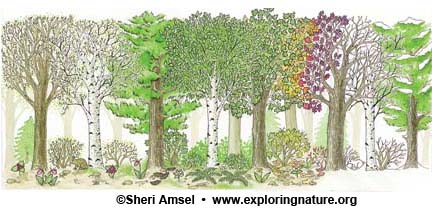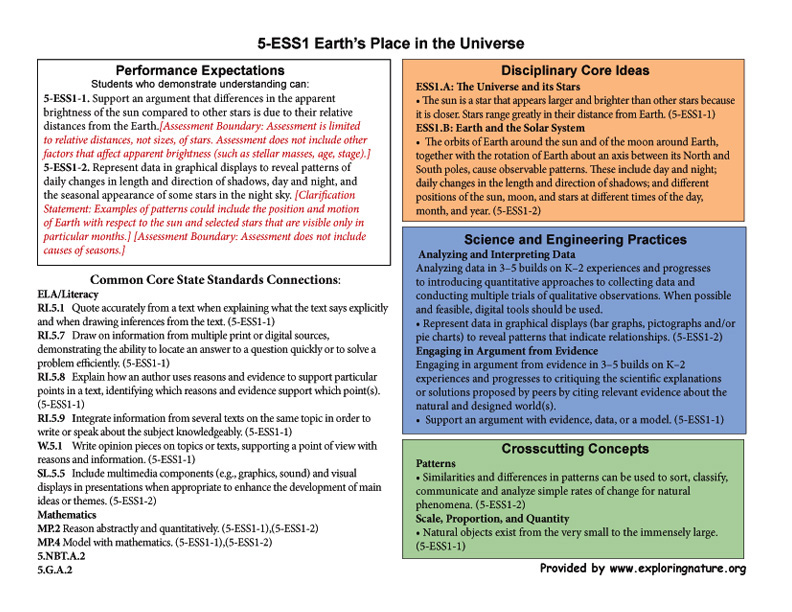

Earth Science For Grade 5
LINKS to content and activities to help fulfill the Next Generation Science Standards shown below.
ESS1.A: The Universe and its Stars
ESS1.B: Earth and the Solar System
Next Generation of Science Standards (NGSS) - Grade 5
Disciplinary Core Ideas
ESS1.A: The Universe and its Stars
• The sun is a star that appears larger and brighter than other stars because it is closer. Stars range greatly in their distance from Earth. (5-ESS1-1)
ESS1.B: Earth and the Solar System
• The orbits of Earth around the sun and of the moon around Earth, together with the rotation of Earth about an axis between its North and South poles, cause observable patterns. These include day and night; daily changes in the length and direction of shadows; and different positions of the sun, moon, and stars at different times of the day, month, and year. (5-ESS1-2)
Science and Engineering Practices
Analyzing and Interpreting Data
Analyzing data in 3–5 builds on K–2 experiences and progresses to introducing quantitative approaches to collecting data and conducting multiple trials of qualitative observations. When possible and feasible, digital tools should be used.
• Represent data in graphical displays (bar graphs, pictographs and/or pie charts) to reveal patterns that indicate relationships. (5-ESS1-2)
Engaging in Argument from Evidence
Engaging in argument from evidence in 3–5 builds on K–2 experiences and progresses to critiquing the scientific explanations or solutions proposed by peers by citing relevant evidence about the natural and designed world(s).
• Support an argument with evidence, data, or a model. (5-ESS1-1)
Crosscutting Concepts
Patterns
• Similarities and differences in patterns can be used to sort, classify, communicate and analyze simple rates of change for natural phenomena. (5-ESS1-2)
Scale, Proportion, and Quantity
• Natural objects exist from the very small to the immensely large. (5-ESS1-1)
Students who demonstrate understanding can:
5-ESS1-1. Support an argument that differences in the apparent brightness of the sun compared to other stars is due to their relative distances from the Earth. [Assessment Boundary: Assessment is limited to relative distances, not sizes, of stars. Assessment does not include other factors that affect apparent brightness (such as stellar masses, age, stage).]
5-ESS1-2. Represent data in graphical displays to reveal patterns of daily changes in length and direction of shadows, day and night, and the seasonal appearance of some stars in the night sky. [Clarification Statement: Examples of patterns could include the position and motion of Earth with respect to the sun and selected stars that are visible only in particular months.] [Assessment Boundary: Assessment does not include causes of seasons.]
Common Core State Standards Connections
ELA/Literacy
RI.5.1 Quote accurately from a text when explaining what the text says explicitly and when drawing inferences from the text. (5-ESS1-1)
RI.5.7 Draw on information from multiple print or digital sources, demonstrating the ability to locate an answer to a question quickly or to solve a problem efficiently. (5-ESS1-1)
RI.5.8 Explain how an author uses reasons and evidence to support particular points in a text, identifying which reasons and evidence support which point(s). (5-ESS1-1)
RI.5.9 Integrate information from several texts on the same topic in order to write or speak about the subject knowledgeably. (5-ESS1-1)
W.5.1 Write opinion pieces on topics or texts, supporting a point of view with reasons and information. (5-ESS1-1)
SL.5.5 Include multimedia components (e.g., graphics, sound) and visual displays in presentations when appropriate to enhance the development of main ideas or themes. (5-ESS1-2)
Mathematics
MP.2 Reason abstractly and quantitatively. (5-ESS1-1),(5-ESS1-2)
MP.4 Model with mathematics. (5-ESS1-1),(5-ESS1-2)
5.NBT.A.2
5.G.A.2
When you research information you must cite the reference. Citing for websites is different from citing from books, magazines and periodicals. The style of citing shown here is from the MLA Style Citations (Modern Language Association).
When citing a WEBSITE the general format is as follows.
Author Last Name, First Name(s). "Title: Subtitle of Part of Web Page, if appropriate." Title: Subtitle: Section of Page if appropriate. Sponsoring/Publishing Agency, If Given. Additional significant descriptive information. Date of Electronic Publication or other Date, such as Last Updated. Day Month Year of access < URL >.
Amsel, Sheri. "Grade 5 - 5-ESS1 Earth’s Place in the Universe" Exploring Nature Educational Resource ©2005-2024. December 13, 2024
< http://www.exploringnature.org/db/view/Grade-5-5-ESS1-Earths-Place-in-the-Universe >

